
Vermilion Ohio, A Good Place to Live
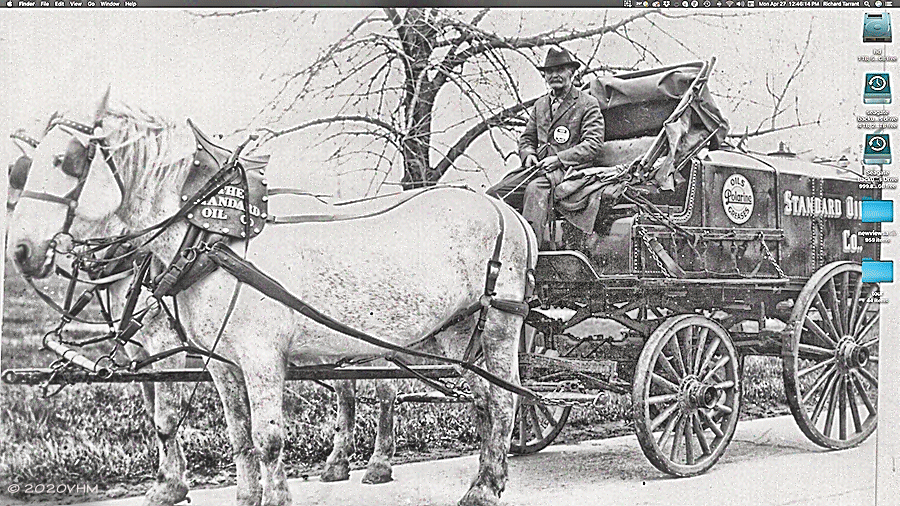
SHOPTALK: JOHN S. WALPER was 70 years old when he stopped his span of grays and proudly posed for Pearl Roscoe’s camera during the spring of 1929. It was his 28th year of service driving a gas wagon for the Standard Oil Company in the Vermilion area. On his chest he proudly displayed the badge the company had belatedly given him for 25 years of faithful service. And then he was on his way.
Walper was born in Ohio in 1859 of German parents who had, like many German people, left their Vaterland during the German Revolution (1848-49) and ventured to America, Ohio, and finally Vermilion. As a younger man he had worked at the Decker Livery on Liberty Avenue resigning at the very turn of the 20th century to work for Standard Oil.
By 1900 the Standard Oil Company had been in the oil refinery and distribution business in Cleveland for 30 years. However; practical applications for the by-products of crude oil were not as significant as they are today. During the first 20 years Mr. Walper worked for them the products he distributed were primarily used for home and business heating systems, stoves, and lamps. It was not until the automobile became both a practical and affordable mode of transportation that the demand for Standard’s products drastically increased.
And thus, it was that for nearly 30 years John S. Walper drove a span of grays down unpaved roads in and around Florence, Berlin Heights, Birmingham, and Vermilion distributing oil, gasoline, and kerosene to citizens throughout the countryside. During these years he wore out 3 wagons, which the company was quick to replace, and he was always furnished with beautiful, well-kept, horses.
When motor powered vehicles had finally been perfected Standard Oil, logically, began to replace their horse drawn wagons with motorized trucks. But for reasons unknown the company continued to keep Mr. Walper and his horses in service.
About 1920 they gave him an assistant with a motorized vehicle who took care of deliveries (primarily of gasoline for automobiles) to outlying Vermilion precincts. Prior to this time Walper and his trusty team had been accustomed to covering a distance of nearly 40 miles daily. And workdays of 12 to 14 hours, despite weather conditions, were the rule - not the exception.
In addition to this Standard Oil always required daily reports to be filed and sent to their Cleveland headquarters. For this work Mr. Walper depended upon the skills of his daughter, Margaret (Mrs. Andrew) Kneisel. Until her marriage she had lived with her father and mother, Martha, in their home on State Street. Margaret had also worked for the Englebry Coal Company (later Hull) as a bookkeeper.
Although his regular route had been substantially reduced to about five or six miles, once given an assistant, practically every farmer in the area still had one or more fuel tanks in need of filling on a very regular basis. They still needed gasoline for their new machines (i.e. automobiles) and kerosene for their stoves and tractors. Mr. Walper, in short, kept busy.
A gentleman by the name of Sam Ewing once opined that, “It's not the hours you put in your work that counts, it's the work you put in the hours.” That being said I am convinced that John S. Walper always earned his keep.

BUSY, BUSY-NESS: Things may be shut down all over the place (including the museum), but I am forever busy. The Vermilion Food Pantry business has kept me hoppin’ – bringing items in, and sorting and shelving them. People are very generous. The mask wearing is annoying. So I appreciate working alone, or with just my wife or brother-in-law, at Pantry. It’s not that I wouldn’t like to have more help – it’s the damn virus. I don’t want to get it and help perpetuate it by working with a bunch of people.
I really like my 360° camera. But I’m just learning how to do presentations – like the Museum Tour. It’s tedious work that requires taking a number of regular still pix to use in the tour (as you will see) – and placing them in areas where they can be easily accessed by tourists. I also intend to add some audio and video at certain places in the tour. At the moment, I’m not real happy with the quality of some of the 360° pictures. But I’m working on making them better. Lighting seems to be is a real problem. The camera (you will note) is very sensitive to light sources – bright and dark. Working with it will require some careful editing (and practice).
I also have to take my time putting things together. I grow weary of that which soon becomes extremely tedious work and begin making very simple errors which, in turn, draws out the process.
All of this busy-ness makes it very easy for me to forget about C-19 for a while. And that ain’t really a bad thing.

BACK TO BASICS: In the meantime I am moving away from the aforementioned virtual stuff back into the museum itself, working on developing exhibits. One exhibit will feature metal photo engravings and print dies / blocks. The museum has (probably) a thousand or more of these items – many that go back to the early years of the 20th century. They are generally made on a copper or steel plate coated with a photo-sensitive material. The dies / blocks are usually made of zinc or magnesium. Some are Stereo blocks (i.e. made from a mold, no machine marks on the surface); and some are Electro: identical in manufacture and physical characteristics to the stereo, except that the surface has been electroplated with copper to increase useable life.
These are fun artifacts to look at. I intend to set up a place where visitors can make a block print souvenir for themselves as part of the tour through the print shop part of the museum. I also have a (dated) video showing how the photo engravings are / were made. It’s rather long, so I may have to do some editing. But it’s very interesting.

A NEW WEBPAGE: During the week I put together a new page with (1) A Virtual Tour of the entire Vermilion History Museum and (2) a 360* view of Main Street Beach with the Harborview Mansion. I'm not finished with the museum tour yet. But as I add items (including some audio) it will automatically be reflected on this page. So take a look and keep coming back. It's fun. You'll find it @:






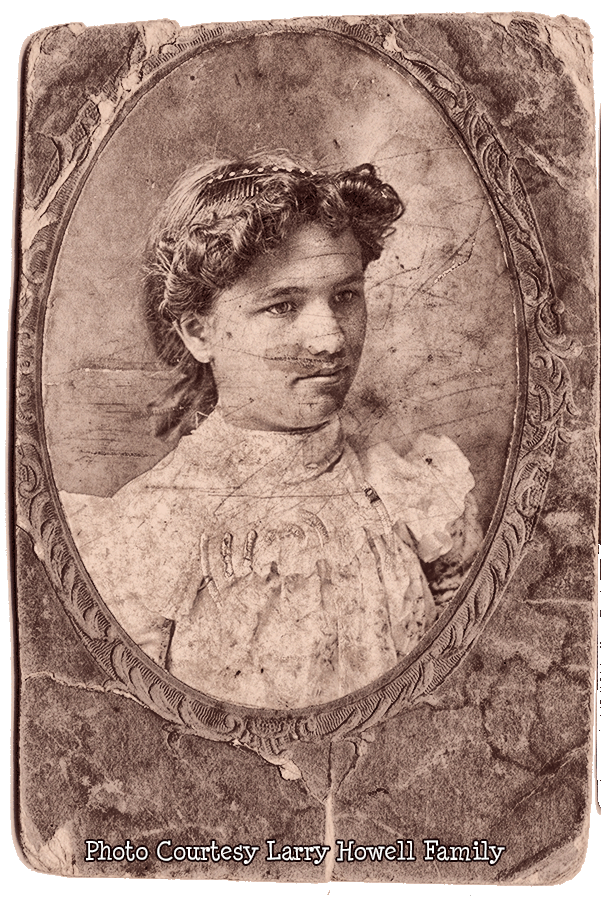
LILLIAN HANDY-HOWELL: Lillian Arnold-Handy-Howell was the wife of George W. Howell. She was born on the 22nd day of November in the year 1884 and died on the sixth day of March in 1967. The couple had five children; Vera, Irvin, Jessie, Alice and Myrtle. Her father, Frances Charles Handy (interestingly enough) was born at sea. She had married George on the 26th day of February in 1902 at the tender age of 17 years.
Of the children I knew Irvin and Myrtle best. Myrtle was likely the very first female minister in Vermilion. An interview video featuring her when whe was nearly 100 years old, can be viewed in the Vermilion History Movie Theatre linked to this site.
Irv born in 1906 worked for the railroad. He died in 1997. He and his wife Jenny Boone-Howell were the parents of two children; Larry E. and Etta. Irv and Jenny were really nice people and so were / are their children. While Etta, unfortunately, passed away in July of 2019, Larry E. is still around. He is a good friend to many – myself included. Larry knows everyone in the world. (Or it often seems like it.)
In any case, the Howells were, and remain, very friendly and prominent people in the community of Vermilion, Ohio
.

STILL SHOWING: Several weeks ago I added a slide show: Now & Then (at the museum and around town). It's about 20 minutes long. It was something I originally did for the Vermilion Area Archival Society. When originally presented I did some commentary as I changed slides. The production is without that commentary - but has some great music with it. I think you will like it. I have added one more old pod cast as well.
Anyway, have a look.

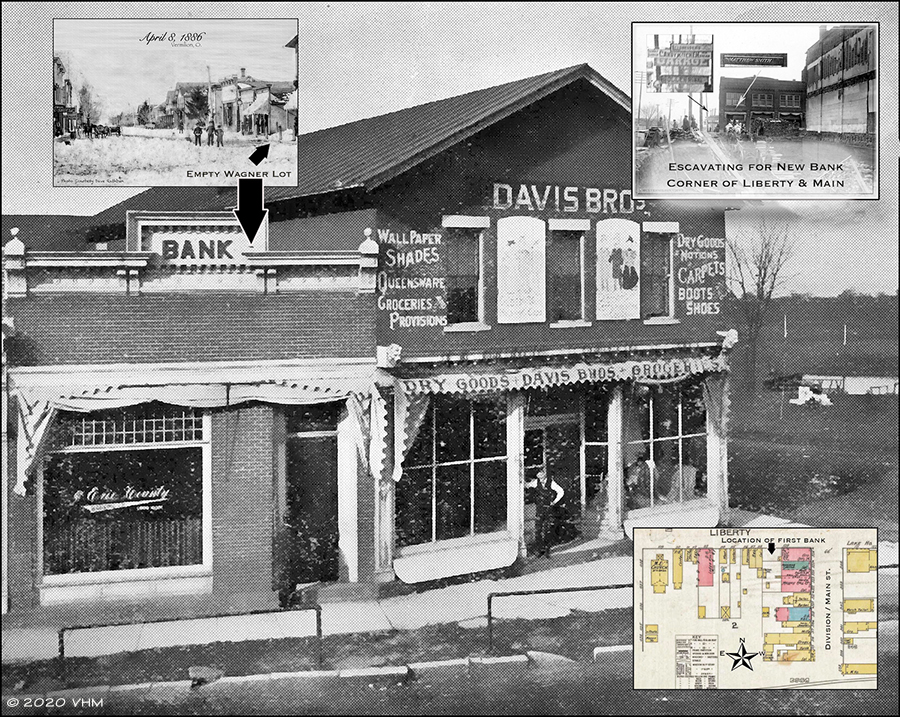
THE ERIE COUNTY BANK: Currently most people know the building as the site of the Vermilion City Mayor’s Office et al. But in a yesteryear (from 1922 until sometime in the late 1960s) it was the headquarters of the Erie County Bank. What follows is the story of that bank:
As many persons know, Vermilion’s initial growth (platted in 1837 and incorporated in 1838) was due to the bustling business life that thrived along its docks on the river where small vessels of an era long past loaded cargoes of staves, stone and grain and discharged occasional cargoes of limestone and iron ore for the local lime kiln blast furnace. And then there were the local shipyards where many of the wooden vessels on the lakes during those days were constructed. Local ship builders, owners and local merchants prospered for a time. But regrettably, they left for the larger harbors in places like Cleveland, Chicago and other harbors along the lakes where prospects for the expanse of their enterprise along with increased capital were more available.
Following their departure, the area developed into an important commercial fishing, farming, produce and fruit growing region. Railroads were built and the population of both Village and country increased. And with these developments came the gradual accumulation of capital resulting in an increased need for local banking facilities.
Around the year 1890, the attention of the Dwiggens Starbuck & Company, a well-known banking company of Chicago, was called to Vermilion to establish a bank in the busy town. Following their investigation, a co-partnership was formed under the title of “The Erie County Bank.” Initially it was composed of members of the Chicago firm, and their associates along with a Vermilionite named Edward L. Coen.
At that time a two-story frame building sat on the lot on the southwest corner of Liberty and Division / Main streets. On the lot behind it (on Liberty) there was a one-story building. Both were owned by a local entrepreneur named Lewis Wells. Wells (b.1815 -d. 1897) was an early Vermilion grocer. The one-story building was divided into two business rooms; the west one being occupied by one Chris Smith who operated a hardware store. The east side of the building was rented by the bank. The bank room was furnished with a safe, fixtures, etc. It opened for business Tuesday morning April 21, 1891. While business was slow at first, over the next few months it began to increase.
The bank was not quite eight months old, when early on the morning of December 16th fire destroyed the two-story building, as well as those adjoining it including the new bank. While all the furniture and other office equipment in the bank room were destroyed, the safe came through with flying colors. All money, securities and important records were preserved. Immediately space was rented in John Ritter’s tailor shop, another safe was hastily installed and by Dec. 21st the bank was back in business. Later a site was purchased from Nicholas Wagner, and a bank building was erected, [pictured] furnished and business commenced there on April 28, 1892. [It is currently the site of the “Olive Scene”.]
Business in the new building grew rapidly. It was then that the organizers of the bank and many representative citizens concluded that there was sufficient business in the community to justify incorporating and placing the bank on a permanent basis. Ergo, the Erie County Banking Company was incorporated June 18, 1892, with an authorized capital of $50,000.00, all of which was promptly subscribed and paid; $35,000,00 of the capital stock was subscribed by our home people and the $15,000.00 taken by the Chicago interests was later bought by local investors. [NOTE: that $50,000.00 would today be about a million and a half dollars.]
Meanwhile in the space where once Well’s grocery and the first bank office once stood a new block was constructed by one Captain Edison. In the new building the local Masonic lodge offered to rent the second floor of the building for a decade with an annual rent of $100, with an option to extend the lease for another 10 years thereafter. Captain Edison accepted their offer and “Bro.” F.H. Rae was given the task of planning the arrangement of the lodge rooms. The Lodge opened on January 1, 1893.
For a time, the Lodge membership considered building a new Masonic Temple. When the federal government – in 1923 – was selling the “Light Keeper’s” home [currently the Paradise Hair Salon] on the southwest corner of Grand and Liberty streets. Members formed a company and purchased the property for that purpose. But in 1926 they were unexpectedly presented with an opportunity to purchase the block where they were located, they jumped at the prospect. Now in possession of the entire second floor of the building they remodeled and enlarged the old temple banquet and clubrooms. And there, with of course various physical alterations, it remains to this day.
The corner store, below the temple, was soon occupied by the Pelton-McGraw general store with various other shops adjoining it. The lot behind it where the old bank had once stood was now empty and was being used for storage. In the early 1920’s amid the ever-changing environment in business trends in the U.S. and, inevitably Vermilion Village, the part of the building containing the general store and the empty lot behind it were purchased by the no longer “fledgling” Erie County Bank. In 1922 the Pelton-McGraw portion of the building - that which once served as the literal hub of local commerce - was razed to make way for a new bank building.
In time, regrettably or not, most all things change; and the banking industry was included. Little corporations fail or are swallowed by bigger ones. And in the case of the Erie County Bank it was eventually absorbed by KeyCorp of Cleveland. The facility was then moved into a large new building further east along Liberty Avenue. It was constructed on the gravesite of the old Crystal Gardens dancehall across from the town’s South Shore Shopping Center. I miss the old place (both the bank and the dancehall). But as someone sagely and bluntly observed in a 2004 Wells Fargo Annual report, "Banking is necessary. Banks are not." You bet.


YESTERYEAR'S NEWS: The following clips are dictated transcriptions from past issues of The Vermilion News. I think you will find them both interesting and fun...

By the decision of Judge Stahl Friday noon, Mrs. Pauline Ostheimer was a winner in her struggle with Adam Ostheimer, from whom she was divorced, for the possession of it an 8 acre farm in the city. The land is valued at $2400.
Mrs. Ostheimer was awarded the custody of the two minor children, Sophie, aged 12, and Fred 7.
The court refused to order the sale of the land, and division of the proceeds between the parent parties. “It would be better to leave the place to Mrs. Ostheimer, so that she and her family will be sure to have a home”, said Judge Stahl.
Mrs. Ostheimer was ordered to pay the cost in the case. The suit has occupied the attention of the Common Pleas Court for most of the week. -Star-Journal.
Trial of the case of George A. Boeckling, president of the Cedar Point Resort Co., against the West Huron Sporting Club, to secure right-of-way for a proposed automobile Road through the club’s hunting reserves along the Lake Erie shore, was practically completed in the Court of Common Pleas Wednesday.

BORN – to Mr. and Mrs. Geo. Brown a daughter, Saturday, April 27, ‘12.
The home of Mr. and Mrs. George Johnson was damaged by fire Saturday evening to a considerable extent. Both were away from home at the time, and neighbors and friends gathered at the home and soon extinguish the blaze.
The remains of Harry Hoffner, of Collinwood, were brought to the Brownhelm Cemetery for burial on Friday. Mr. Hoffman was a former Amherst resident. He leaves to mourn their loss, a wife, two sons, and a daughter.
The funeral service of George Kreiteburg, son of Mr. and Mrs. Ed Edward Kreiteburg was held on Wednesday afternoon at 2 o’clock from the St. Peter’s Evangelical church. Rev. Lindenmeyer officiating. The deceased was but 24 years of age. He leaves a wife, parents, two brothers and several sisters, besides a host of friends to mourn his departure. His remains were interred at the Crown Hill Cemetery.

The funeral of Mrs. Susan Smith was held at her old homes Saturday 27th, 12. She has been a resident of this place for more than 57 yrs., leaves many friends and neighbors to mourn her departure. The floral tributes were many and beautiful. Those in attendance from out of town were: Mrs. Coulton; Cleveland, Mrs. Tena Carpenter, Ida Miller, B. G. Smith, Lewis Nichols and wife of Lorain; Jas. Corbin and wife, Mrs. F. B. Parsons, Mrs. H. H. Patton and Miss Mrs. Eliza Driver, Vermilion; Mr. Smith Washburn and wife, Greenwich, Mrs. Walter Bell, Mrs. Noah Campbell and Mrs. Susan Green, of Norwalk; Capt. Pearl and wife, Mr. Jas. Anderson and wife, Mrs. Sarah Young, Huron and Carrie Gibson of Birmingham. L. H. Smith and wife and daughter from Sandusky; L. M. Darrow and wife and M. H. Darrow, Milan.

The Vermilion fish tug Charles A. Trinter, of Vermilion, and sailed by Capt. Edward Lamp [sic], Vermilion, was badly damaged by fire at Port Clinton last Thursday afternoon. Members of the crew had been making repairs to the engine had left the boat when fire was discovered. The mooring ropes quickly burned, allowing the vessel to drift out into the river, beyond the reach of hose, but firemen managed to reach her and towed her back to a dock where the blaze was extinguished, after the cabin and deck had been destroyed, together with fifty gill nets. The loss is estimated at $3000. The tug will be rebuilt at once. Meantime the Union Fish Co. tugs will look after Lamp’s [sic] nets already set.

All the work on the Huron bridge has been completed with the exception of the approaches on both sides of the structure.
Commissioners expect that the bridge will be ready for use before fall. Bids for the work on the approaches will be received at the courthouse May 8.

Mr. Frank Clark, for many years a resident of Vermilion, died at ten o’clock this morning, at the home of his daughter, Mrs. Geo. Harris. Mr. Clark has been in poor health for the past several years.

Frank, the 16-year-old son of Mr. and Mrs. Henry McVetta who disappeared from his home at Shinrock, March 20, is not been heard of yet.

The W. R. C. Are anticipating a pleasant afternoon Tuesday at the home of Mrs. F. W. Wakefield.
Capt. Full left this week to begin his season duties on the lakes.
The tug Comet, and crew join the fishing fleet at Fairport suite.
Capt. Charles Hahn, William Parsons and H. W. Haber and Ray Friday were among the sailors to leave for the season’s work this week.
Mr. and Mrs. Geo. Fisher and son enjoyed a delightful trip to Cleveland in their new auto Sunday. They were a accompanied home by Mr. and Mrs. O. A. Priest.

More than eleven of the fifty thousand passenger cars in use on the railroads of the U. S. are now electrically lighted.
A device by which a passenger from any point within an automobile can regulate its speed, without the knowledge of the chauffeur, has been invented in Germany.

Mrs. Lippus living east of town went to the St. Joseph’s Hospital, Lorain, Monday, and had an operation Tuesday, which was very successful. The trouble was not so serious as was anticipated and it is expected and hoped that she will return within a few weeks, a well woman. Her son, Winfield was present and witnessed the operation.
The body of Mrs. Williams, wife of Rogers Williams, arrived here from Florida, Saturday and Sunday morning on the early L. S. E. R. And was buried Sunday afternoon from the Home in Berlin where they had formerly resided. Mrs. Williams had undergone an operation was on fair way to complete recovery when she suffered a relapse which within a few days ended her life.
The Council of Berlin Heights granted the Logan Gas and Fuel Company a franchise at their meeting Tuesday night. Quite a number of citizens attended the meeting showing interest in the new project. The company expects to have the nearly two miles of pipe laid by 20 June, so that the citizens of this of the village can use gas by 1 July. Measurements of the extent of pipeline will be made this week. That’s going some.

Susan Elizabeth Johnson Smith was born in Amherst, Lorain Co., Ohio, November 27th, 1828 and died at the advanced age of 83 ys., 4 mos. 27 days. At the age of 12 years she was converted and united with the Baptist Church and had continued to be an earnest and consecrated disciple of her Lord and Master ever since. Hers was an everyday Christian life, doing what she could to reproduce the spirit of her Christ.
She was united in marriage to Horace T. Smith, and Elyria, O. Oct. 16, 1854. To this union were born five children, Mrs. A. J. Nichols, Chas. F. Gurdon, W. Lucius H. [sic], and Norton T. Smith. Her life was one of hard toil, ever doing and helping others in time of sickness in and need. She was kindly disposed and had a pleasant word for everyone. During the later years of her life her only daughter had cared for her and had been constantly by her side to cheer and comfort. She was a loving mother, kind, tender and thoughtful. A highly respected neighbor and an honored citizen. The funeral was held from the home Saturday afternoon and the services were conducted by Rev. A. G. Rupert.

Mr. Shoemaker is on the sick list.
Miss Martha McBride is quite ill with Lagrippe.
Mr. Edwin Crandall who has been quite ill is improving.
Will Snyder has been ill for the past week nursing a bad cold.
W. P. Funk is busy selling machinery and buggies.
Two carloads of Oberlin students visited Birmingham Saturday.
The Methodist people of Florence started work on their new church, April 30th.
The younger son of Mr. and Mrs. John Bauman Jr., broke his collarbone one day last week.
Carl Neiding had the misfortune to fall break his collarbone Saturday.
Mrs. Pearl Roscoe and daughters of Vermilion were guests of Mrs. Roscoe’s sister, Mrs. W. B. Houseman, Saturday.
Edna Gerber, who was staying with her brother, Fred Gerber family at Pittsfield, spent Sunday with her mother, Mrs. Dan Gerber.

An electrically operated coin in the slot machine has been invented in Switzerland for cleaning the souls and sides of a person’s shoes when entering the building.


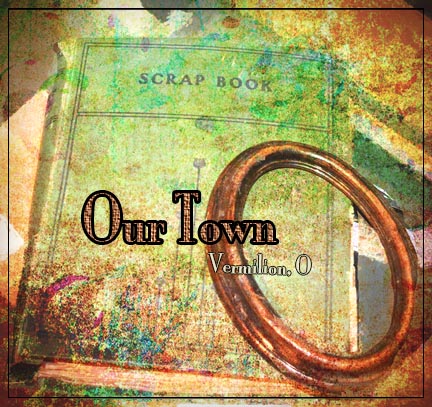
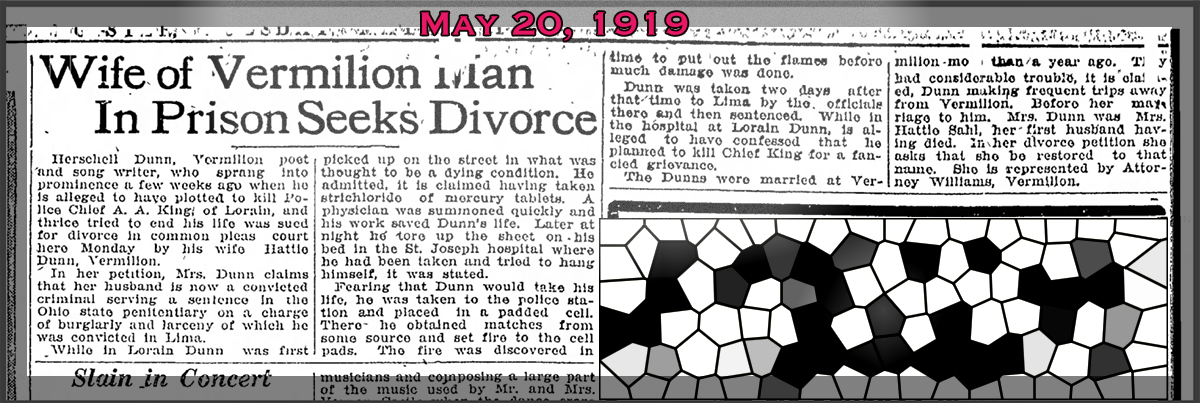


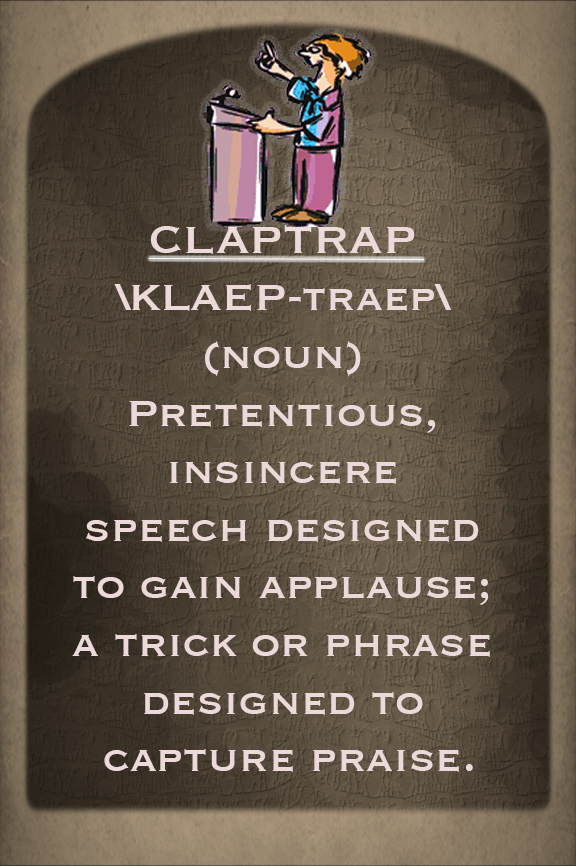








…on the old Mad River road was taken: “ My step father, Conrad Poppenbo," he said, “ was married to my mother, Lucaea Burman, in the old country fifty years ago. My father, Anton Riedenbusch, had his residence in the castle Windau, Westphalia, and was a high officer in the government service. He died in 1832. For some reason our mother never acquainted us with our father's name till we were grown up, and we had in the meantime adopted the name of our former estate, ‘Windau.' The family consisted of five of us when we emigrated in 1835, my parents and three of us children, viz.: Joseph Riedenbusch-Windau; Moritz Riedenbusch, Seneca county; and Hermann, of Sandusky. Sandusky became our home in the same year, and I have lived and worked here faithfully for nearly half a century." Standing in the yard of the old Mad River Company's shops he pointed out a landmark; “where you see the three old oak trees near the Market street entrance," he said, “Davidson's slaughter-house was standing fifty years ago; to your left and only a short distance from the paint-shop was the boundary line of the first burying-ground in Sandusky, that was located at the foot of Shelby street. Everything has changed. I was a mere lad of twelve or thirteen years when the first road to Bellevue was surveyed in 1839, but I recollect it as well as to-day, when I was carrying the chain and made myself generally useful. After the strap rails were laid Thomas Hogg became the first engineer on the primitive branch of the road, and my stepfather, Conrad, became his fireman. In my recollection the Lane, Erie, Sandusky and Wyandotte were, in the order named, the first engines operated on this road. The crew consisted of three men, an engineer and a fireman, and wood passer. They worked by the day and received $1.50 and $1.00 respectively. It was customary in those days that everybody had to work himself up on the ladder. After Thomas Hogg's promotion to the place of master mechanic, my father took charge of Tom's engine, and Paul Klauer, who settled here in 1837, became his fireman. After Klauer's promotion, a few years later, he engaged John Hauer as fireman, who, in due time, was entrusted with an iron horse of his own. Both died of the cholera in 1849. Paul Klauer, in harness, being taken sick on the road, was carried from his engine into the station house at Urbana, where he died. His widow, Catharine, was married in 1852 for the second time, choosing Math. Dietz-as a partner. She is living on Fulton street in feeble health. ‘This reminds me,' said my captive, ‘of a curious affair that occurred in the first years after the old Mad River road became operated. A young man, by name Besterman, had found employment on one of the locomotives as fireman, and had made a trip or two when his work terminated rather abruptly. His aged mother, after having implored him to give up the devil's work, threw herself bodily before his engine as he was ready to pull out, and prayed so fervently to give up the devil's wagon that her prayer was answered. He resigned the same day and moved subsequently to Cincinnati…




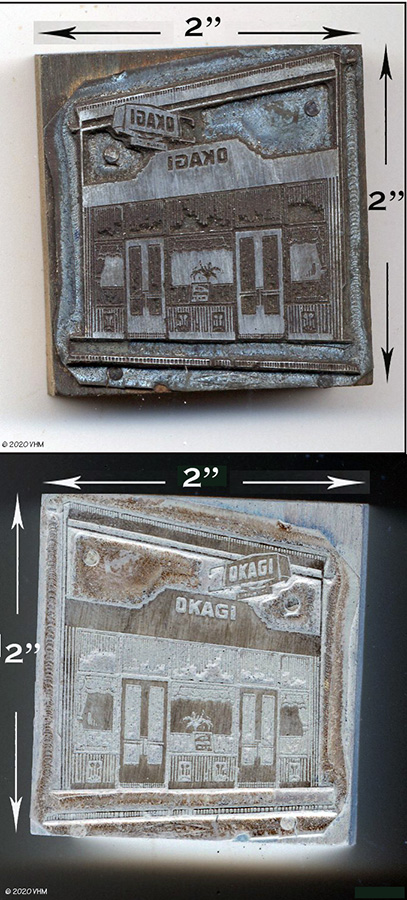
A STEREO BLOCK: This Okagi block is one of the stereo blocks mentioned at the tope of the page. I placed the size of the artifact in to illustrate just how small some of them are. (That's part of the reason we have over 1000 of them.) This one is in good shape and (I've not done it yet) I can likely make a nice print of it using an ink pad.


"You and your husband don't seem to have an awful lot in common," said the new tenant's neighbor. "Why on earth did you get married?"
"I suppose it was the old business of 'opposites attract'," was the reply. "He wasn't pregnant, and I was."





LOCAL ANNOUNCEMENTS: After giving it much thought this link has been "put-down". During the last year most of the folks who used to use this page as a bulletin board have acquired their own and, consequently, no longer need this forum from "Views". I have, however, kept links (in the links section) to Larry Hohler's "Hope Homes" in Kenya - and to Bette Lou Higgins' Eden Valley Enterprises sites. They are historically and socially relevant projects. I suggest that you visit these sites on a regular basis to see "what's shakin'".

Persons interested in the history of the Lake Shore Electric Railway (which was the subject of a recent past podcast series) - "the greatest electaric railway system on the planet" may want to go to Amazon.com and purchase a book called "Images of Rail - Lake Shore Electric Railway". It was put together by Thomas J. Patton with the help of my friends DENNIS LAMONT and ALBERT DOANE. It'd make a nice gift.
Another great book with Vermilion Roots is, "Grandma's Favorites: A Compilation of Recipes from MARGARET SANDERS BUELL by Amy O'Neal, ELIZABETH THOMPSON and MEG WALTER (May 2, 2012). This book very literally will provide one with the flavor of old Vermilion. And ye can also find it at Amazon.com. Take a look.
MARY WAKEFIELD BUXTON'S LATEST BOOK “Tripping: A Writer’s Journeys.” Signed copies of her new book can be purchased for $15.00 at the Southside Sentinel office or by mail by writing Rappahannock Press, Box 546, Urbanna, VA and adding $6.00 to cover mailing costs and tax. Contact:glongest@ssentinel.com.

















THE BEAT GOES ON: This page is generated by a dreaded Macintosh Computer and is written and designed by (me) Rich Tarrant. It will change weekly ~ usually on Saturday. Bookmark the URL (Universal Resource Locater) and come back at your own leisure. Send the page to your friends (and enemies if you wish). If you have something to share with those who visit this page, pass it on. And if you see something that is in need of correction do the same. My sister, Nancy, is a great help in that respect. It only takes me a week to get things right. And follow the links. You might find something you like. If you experience a problem with them let me know. Also, if you want to see past editions of this eZine check the new archives links below.

If you're looking for my old links section (pictured) I've replaced it with a pull-down menu (visible in the small box next to the word "Go"). If you're looking for links to more Vermilion history check that menu.

How the old links menu looked


P.O. Box 437
Vermilion, Ohio
44089
Telephone: 440-967-0988 - Cell: 440-522-8397
or you can use PayPal: (NOTE: IT WORKS NOW)

Vol. 18. Issue 9 - May 2, 2020
Archive Issue #894
| advanced |
© 2017 Rich Tarrant